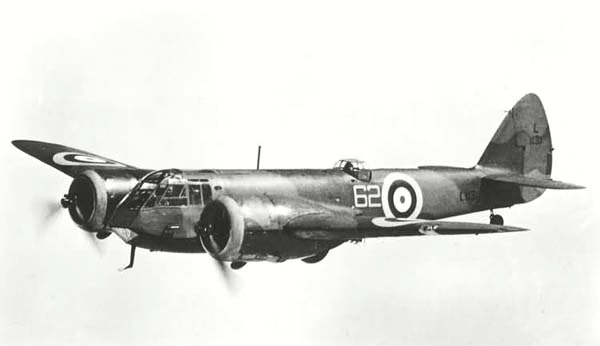Bristol Blenheim History
It was the newspaper magnate Lord Rothmere who asked the Bristol company to build him a fast executive aircraft to carry a pilot and six passengers at 240 mph, appreciably faster than any Royal Air Force (RAF) fighter in 1934. The result was the Type 142, the first modern stressed-skin monoplane in Britain with retractable landing gear, flaps and, after a wait, imported American variable-pitch propellers.
Its performance staggered even the designer, Barnwell, for on Air Ministry test it reached 307 mph. The inevitable result was the Bristol Blenheim bomber, to produce which Barnwell designed a new fuselage with mid-wing and bomb beneath it. Pilot and nav/bomb-aimer sat in the neat glazed nose, and a part-retractable dorsal turret was added behind the wing.
The Bristol Blenheim first appeared in production form as the short-nosed Blenheim Mk I, whose prototype (K 7033) first flew on 25 June 1936. The Blenheim I was ordered in what were huge quantities to a company almost devoid of work. Ultimately 1,134 were built, many of which made gallant bombing raids early in the war and were then converter to IF fighter configuration (some having the AI Mk III, the first operational fighter radar in the world). The fast bomber excited intense foreign interest and many were exported to Finland, Turkey, Jugoslavia, Lithuania, Romania and Greece. To provide a nav/bomb-aimer station ahead of the pilot the nose was then lengthened 3 ft and this type was name Bolingbroke, a name retained for all the variety of Blenheims built in Canada (the Bolingbroke Mk III being a twin-float seaplane).
Most of the Blenheim Bristol bombers were serving in the Middle and Far East, home squadrons of the RAF having already begun to re-equip with the Mk IV.
A revised asymmetric nose was adopted for production in the speedy Mk IV, which later acquired a fighter gun pack (IVF) or a manual rear-firing chin gun (IVL), finally having a two-gun chin turret. With Mercury XV engines replacing the 840 hp Mercury VIIIs of the Blenheim I, the Mk IV was better armed and had a slightly improved performance over its predecessor. One thousand nine hundred and thirty Mk IVs were completed.
The performance of the final Blenheim Bristol British variant, the Mk V, was disappointing. This version was redesigned to meet Specification B.6/40, and in 1941 one Mk VA day bomber prototype and one close-support Mk VB were built by Bristol. Rootes Securities Ltd built nine hundred and forty-two examples, mostly as the Mk VD (a ‘tropical’ version of the VA), but including a proportion of Mk VC dual-control trainers. Combat losses of the Mk VD were heavy, and it was quickly replaced by US Baltimores and Venturas.
During their career the Blenheim Bristol aircraft served with every operational command of the RAF and in every theatre of war.
Bristol Blenheim Specifications
| Aircraft Type: |
| bomber |
| Dimensions: |
| wingspan: 56 ft, 4 in |
| length: 42 ft, 7 in |
| height: 9 ft, 10 in |
| Weights: |
| empty: 9,790 lb |
| gross: 13,500 lb |
| Power plant: |
| 2 × 920 hp Bristol Mercury XV radial engines |
| Performance: |
| maximum speed: 266 mph |
| ceiling: 22,000 ft |
| maximum range: 1,460 mi |
| Armament: |
| 3 × 0.303 in calibre machine guns |
| 1,300 lb of bombs |
| Operational Use: |
| 1937–1944 |





